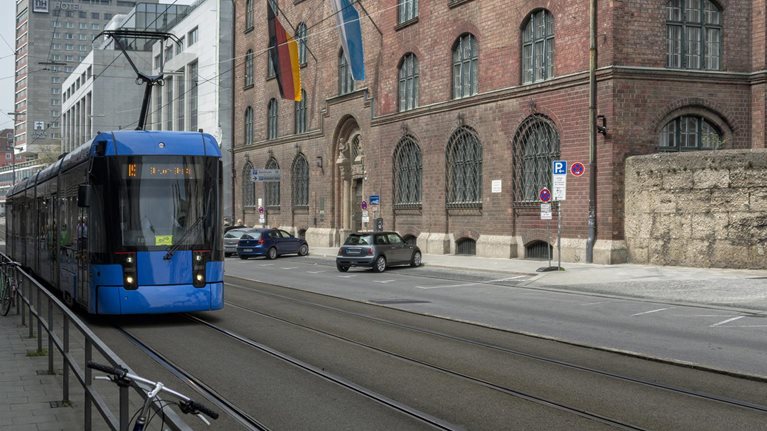Ride-hailing systems, car- and bicycle-sharing networks, trip-planning apps, and other innovative, technologically sophisticated mobility services are winning users in cities around the world. The positive reception these services have received suggests that city dwellers need convenient, flexible transport options at a range of prices—and that existing private and public mobility services offer fewer options than people might like.
Stay current on your favorite topics
Public transit is indispensable for moving people around quickly, preventing traffic congestion and accidents, limiting pollution, and freeing land for uses more valuable than parking space and roadways. But the challenges facing public-transit systems are well known: rising costs, funding constraints, increases in ridership, and aging infrastructure, among others. Private transportation services have long complemented public-transit systems—informal minibus services are ubiquitous in the cities of developing countries—but can exacerbate other urban challenges such as safety and environmental quality.
As new mobility services proliferate, cities have opportunities to combine them with public-transit systems in ways that will improve the lives of city residents. Yet it isn’t obvious how cities can ensure that these services will properly meet their residents’ needs. The right mobility formula depends on a complex set of considerations affecting passengers (access, convenience, cost), transit agencies (finance, regulation), and cities as a whole (employment, environmental impact).
So cities around the world have begun to integrate new private mobility services into their transportation systems through partnerships. While it’s too soon to tell whether these partnerships are succeeding, they do point toward possibilities that other cities may wish to consider. A new report from the Coalition for Urban Transitions,1 Connected urban growth: Public-private collaborations for transforming urban mobility, aims to help cities evaluate these options. The report summarizes the development of new mobility partnerships, identifies potential applications for new mobility services in public-transit systems, and models the economic and environmental impact of those applications. The findings suggest that cities and their residents stand to benefit greatly from the features new mobility services have introduced into urban transportation systems.
Would you like to learn more about our Sustainability & Resource Productivity Practice?
Trends in new mobility services and public–private partnerships
Swelling demand for low-cost, high-quality urban transportation has led to more than 15 years of sustained increases in the ridership of public-transit systems. These conditions have not only put considerable stress on them but also created abundant opportunities for entrepreneurs. New mobility services—capitalizing on advances in technologies such as mobile communications, cashless payments, remote monitoring, data collection, analytics, energy storage, and artificial intelligence—have emerged to offer urbanites a wider array of transport choices than ever before. These services can be grouped into the following four categories.
- Shared mobility—Transportation services, including those that rely on private vehicles, for which access or ownership is shared among people financially or physically.
- Product innovation—Next-generation vehicles and transportation equipment with designs and features that have been engineered for better performance through data analysis.
- Consumer experience—Information services that combine timetables, fares, and other kinds of information on transportation options and make them available to users in real time, according to their preferences.
- Data-driven decision making—Services that aggregate data from multiple parts of transportation systems and analyze these data, often using advanced computational methods, to improve the management, planning, and operation of transportation systems.
Shared-mobility services account for more than half of all new mobility start-ups around the world, and homegrown providers have cropped up in every region (Exhibit 1). E-hailed motorcycle-taxi services have proved popular in Africa, for example, while India’s city dwellers have embraced on-demand shuttle services. Product-innovation companies, which are concentrated in North America, mostly focus on developing self-driving vehicles and electric vehicles. Start-ups that provide information to passengers have flourished as many cities opened access to data about their transit systems. And mapping, navigation, and traffic-monitoring applications dominate the market for data-driven decision services.

New mobility services have encountered a variety of regulatory environments and competitive situations as they began to operate in cities around the world. Municipal authorities, in turn, have responded in different ways. Certain new mobility services, especially on-demand rides, do not fit neatly within regulatory frameworks developed for more traditional private and public transport. Some city authorities have imposed restrictions on new mobility services or prohibited them outright. Others have taken a more permissive approach to them, choosing to observe how they affect public transit and existing private-transport providers before deciding what to do.
In 71 cities, the authorities have arranged partnerships with new mobility service providers.2 These partnerships are diverse, but several common types stand out. One aims to develop consumer-experience services that let passengers easily plan multimodal journeys and purchase the tickets they require. Another common type connects transit agencies with providers of on-demand mobility services: agencies replace bus routes that have the highest fixed costs with on-demand cars or minibuses to give riders greater convenience and flexibility. A third type—first-mile/last-mile applications—uses shared mobility services to provide short trips to and from public-transit stations.
The partnerships between cities and new mobility services point to potential benefits both for cities and their residents. At this early stage, the outcomes of these partnerships have not yet been widely reported. Assessing their implications requires simulating the effects they might have under certain conditions.
Modeling applications of new mobility services for public-transit agencies
To help cities deepen their understanding of what they can achieve by partnering with new mobility services, the Coalition for Urban Transitions modeled the economic and environmental effects of three potential applications for these services. The three applications reflect the common types of partnerships between cities and the new mobility services described in the previous section (Exhibit 2).

London, Mexico City, and San Francisco were chosen as the settings for the coalition’s modeling exercise because they offer a variety of spatial layouts, transit-system characteristics, ridership levels, household-income distributions, and passenger demographics (including smartphone penetration). All of these factors make the results relevant to a range of cities around the world, including those in the Global South. The cities also publish enough data about their transit systems to model the three mobility applications using real-world information.
Dynamic trip-planning and ticketing services
A dynamic trip-planning and ticketing service enables city dwellers to use real-time information to map out urban journeys involving one or more modes of transportation and to purchase all the necessary tickets at once through an app. Studies have shown that enhancing the convenience of riders through such dynamic platforms increases the overall public transportation use by almost 2 percent. Public-transit agencies can also analyze the data such services collect about the activities of users—in line with applicable data-privacy laws—to identify potential improvements for their systems.

The future(s) of mobility: How cities can benefit
Dynamic trip-planning and ticketing services are already available in several cities. Los Angeles, for example, partnered with Conduent to develop Go LA, an app to plan and pay for trips using various modes of transportation, including public transit, personal vehicles, bicycles, and new mobility services. Whim is an application that offers dynamic planning and ticketing for trips using public transit, shared cars, and taxis in and around Helsinki, Finland.
In the models the Coalition for Urban Transitions created for London, Mexico City, and San Francisco, dynamic trip-planning and ticketing services that transit agencies developed in-house reduced their operating costs enough to pay back the up-front investments within as little as two years. The coalition also calculates that such services would increase kilometers traveled by public transport and decrease kilometers traveled by private vehicles. By 2020, such a citywide modal shift would cut annual greenhouse-gas emissions in the three cities by 500,000 metric tons—Mexico City would benefit most—and reduce their total transport emissions by up to 6 percent.
On-demand minibuses
Most modes of public transportation offer little day-to-day operational flexibility. A bus, for example, travels on fixed schedules along predetermined routes to established stops and can hold only a certain number of passengers. On-demand mobility services would let cities change the routes and capacity of certain transit modes according to fluctuations in passenger demand. Companies such as RideCell and TransLoc offer routing platforms that can help transit agencies run their own on-demand minibus fleets. Transit agencies have also partnered with companies to introduce on-demand services.
The Coalition for Urban Transitions modeled the effects of replacing underperforming bus routes with on-demand minibus services covering the same areas. The service would pick up passengers at designated points in response to requests submitted through smartphones. Algorithms would optimize the routes minibuses travel between the requested pickup and drop-off points and adjust the number of minibuses in use as demand varied.
The coalition’s economic analysis indicates that an on-demand minibus service replacing four underperforming bus routes in Greater London would break even after three to four years and generate profits for the public-transit agency thereafter. The coalition’s environmental projections, which covered all three cities, suggest that minibuses would have higher capacity-utilization rates and travel shorter distances than fixed-route buses do. These improvements would cut emissions of greenhouse gases, airborne particulates, and nitrogen oxides even if the minibuses ran on gasoline. Deploying electric minibuses would reduce emissions by over 66 percent in all three cities and by over 90 percent in some cases.
First- and last-mile ride sharing
Studies conducted in the United States show that the use of public transit drops by up to 90 percent when passengers must walk more than half a mile to the nearest transit stop. To counter this effect, cities have experimented with bike-sharing and car-sharing systems, as well as extended bus routes, and used other methods to shorten the time passengers travel to and from public-transport stops. Ride-sharing services are now enabling additional new responses to this first-mile/last-mile problem.
One of the most practical and promising solutions is to cover part of the cost that public-transit passengers pay for ride-sharing services that shuttle them on short trips to or from public-transport stops. The point is to encourage more people to use public transport instead of personal motor vehicles for most of their journeys. This approach is particularly relevant for cities where some neighborhoods have such limited access to public transport that residents mostly choose either to reach transit stations by driving their personal vehicles or to drive those vehicles for the entire journey. Several programs of this kind are up and running: one town in the eastern United States expects to save taxpayers $5 million to $10 million over 20 years by subsidizing shared rides instead of building more parking lots near train stations.
The coalition’s model of a program to serve the residents of San Francisco neighborhoods with limited transit access suggests that the program could pay for itself if low-income households received limited subsidies for shared rides. Increasing the amount of the subsidy and expanding the program to additional households would require the transit agency to spend more. If the program encouraged people to use mass transit instead of a personal motor vehicle by helping them reach public-transport hubs in shared vehicles, the environmental benefits for each city could be significant.
As demand for urban mobility continues to increase, public-transit systems, roadways, and other forms of infrastructure will come under greater financial and physical strain. Now entrepreneurs are creating new mobility services, which are giving cities additional new options to augment or support public transit. None of this will be straightforward, but the effort should be worthwhile. Partnerships that let cities take advantage of new mobility services should make urban transportation more accessible, affordable, and efficient—improvements that all city dwellers should welcome.
Download Connected urban growth: Public-private collaborations for transforming urban mobility, the full report on which this article is based (PDF–1,140KB).


